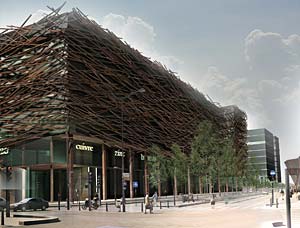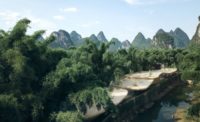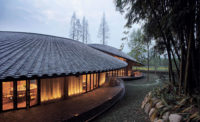“A bird’s nest for a greedy pterodactyl” is how French architect Rudy Ricciotti describes a bamboo building he has designed in Paris. The $41 million project, dubbed T8 after its plot number, will provide offices, shops, and some 40 apartments overlooking an irregular-shaped courtyard pool. Built on a concrete platform astride a railway line, the seven-story, 47,684-square-foot building will occupy a two-acre rectangular site in the up-and-coming Tolbiac Chevaleret quarter, opposite the French National Library.


Rudy Ricciotti surrounded the exterior of the T8 apartment building in Paris with a screen of bamboo, resembling a bird’s nest. Unlike typical French multifamily blocks, the building’s interior features an irregularly shaped courtyard garden and pool.
Wrapped in a bamboo latticework skin, the building is divided into three principal parts by a T-shaped courtyard. Ricciotti, who won the French Grand Prix d’Architecture in 2006, offers here a different approach to traditional Parisian courtyard design. Most courtyards are square or rectangular and lack greenery. In Ricciotti’s project, plant life will hang from green roofs in what he describes as an “imaginary Eden.” The building depth will range from 39 feet to 66 feet, creating an undulating surface of green-tinted glass around the central pool.
In terms of materials and colors, Ricciotti chose a somber palette for the street-side facades. Shop and cafe signs will be made of bronze, brass, or copper. Floor deck profiles will be made of rough black concrete. To bounce daylight throughout the interior, on the other hand, oyster shell-based plaster will line entry halls.
Ricciotti intentionally limited the number of materials in the project, and employed a simple palette, but maximized the ways in which each one was used. “No other material will be used, such as aluminum, PVC, or other rubbish that’s in vogue in the French (construction industry),” Ricciotti says. Residents of this iconoclastic bamboo building should be able to feather their nests when construction finishes in 2011.




Post a comment to this article
Report Abusive Comment